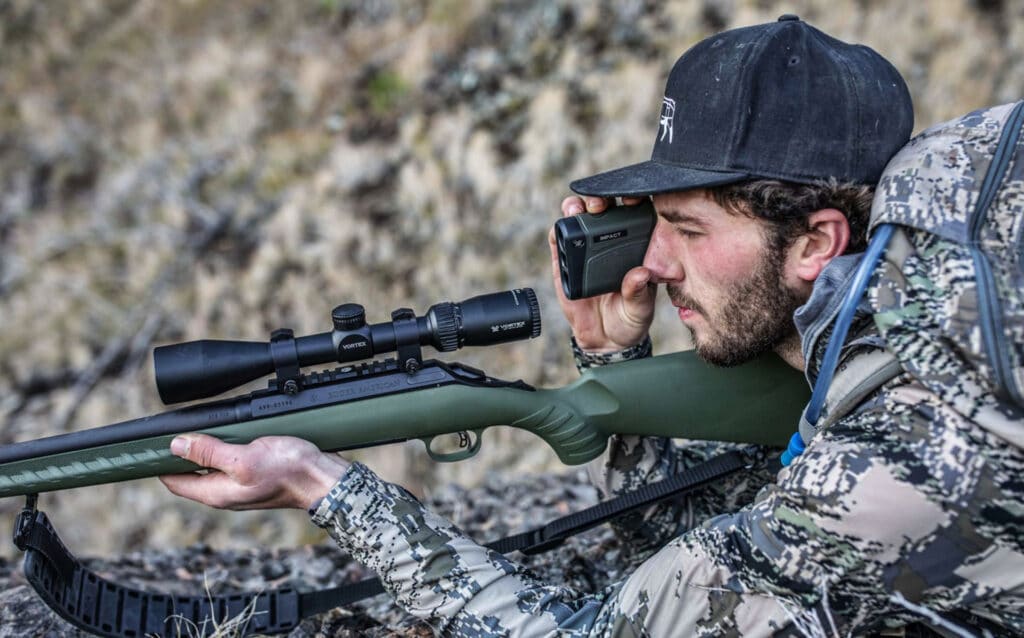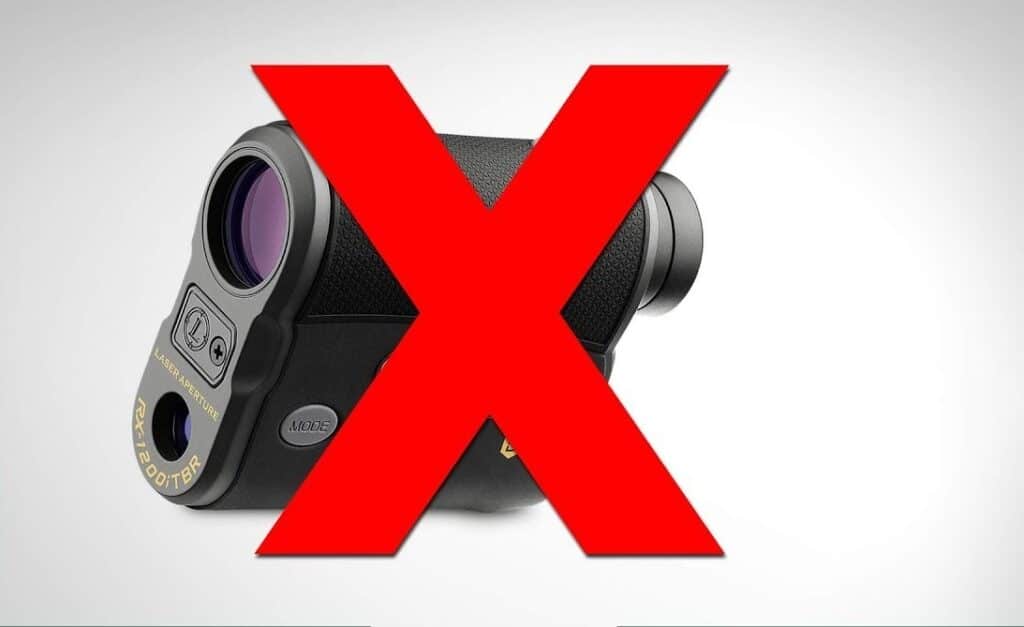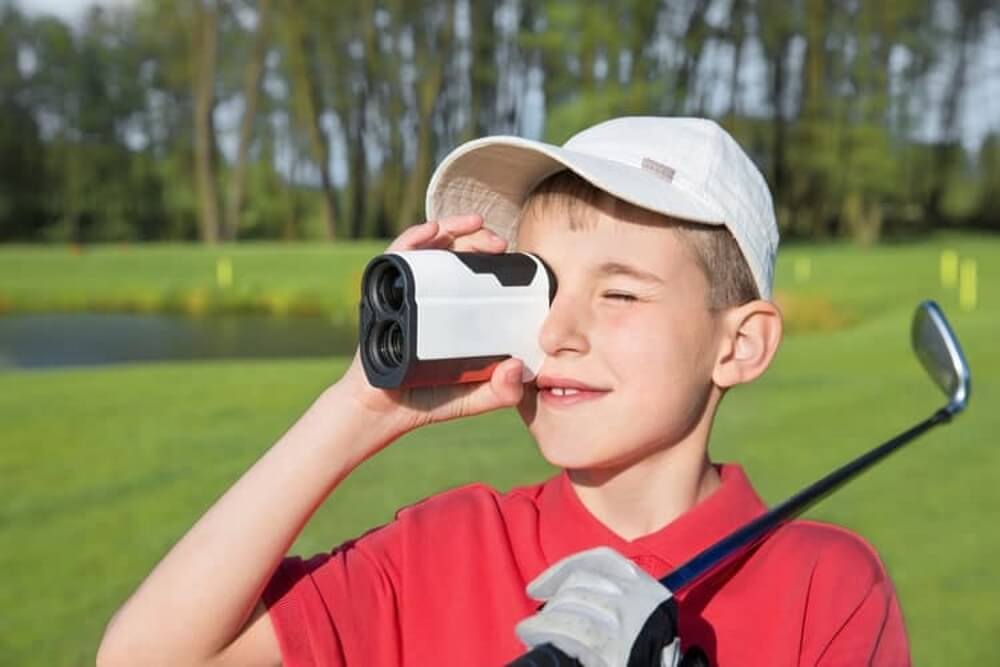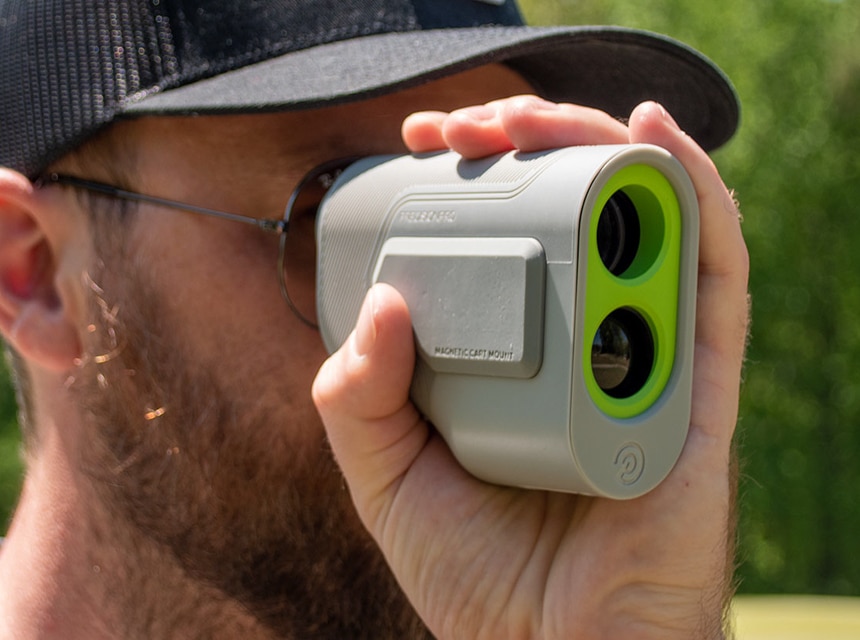

In each of your outings through nature, you face many uncertainties: the weather and finding trails that you can follow. But there is something that you can know precisely: the distance at which the animals you wish to hunt are. And to find this out, you need the best rangefinder for bow hunting. Of course, just any rangefinder will not do. It is important that it is accurate and has a long-range. It must be resistant so that you can use it anytime and under any condition with peace of mind.
Whether stalking, hiding, or patrolling the hunting ground, a range finder can make the job or sport of bow hunting easier in many situations. But the purchase decision is often more difficult than expected given the abundance of manufacturers and models. For this reason, we have selected and listed the best rangefinders for each type of budget. Also, you will find other important information and tips which should make your purchase decision easier.
More features: red TOLED display, XR lens coating, ArmorTek, waterproof, diopter, increment display
The Vortex Diamondback HD 2000 is a replacement for the brand’s Ranger 1800 model, but it increases the maximum reflective range to 200 yards beyond the previous max to 2000 yards. This model has a maximum deer range of 1400 yards, which is 500 yards greater than the Ranger 1800. The minimum reflective range is half of the Ranger’s, but the Diamondback has a slightly more modest price tag, falling in the middle of the new rangefinder series from Vortex.
The rangefinder is supplied with a carry case that has a bungee cord and wrist strap. This makes it easy to keep on hand, but it is quiet to open and easy to open and close even when wearing gloves. This is crucial when you’re hunting, as you don’t want to have to take off your gloves when you’re out early or make excessive noise when getting out your rangefinder which could alert your prey. The case also has a pre installed reversible utility clip, so you can easily connect it to a harness and the wrist lanyard is actually long enough to wear it around your neck.
More features: Archer’s Advanced Software, DNA, Flightpath Technology, fully multi-coated lens system, LOS, scan mode, Plus Point™, Duplex, and Duplex with Plus Point reticles, waterproof, 2-year warranty.
Made for archers, the RX-Fulldraw 4 is a good rangefinder for bow hunting. It combines the ultra-fast precision of Leupold’s DNA® motor with the acclaimed Archer’s Advantage™ software. This makes it the most advanced ballistic rangefinder on the market. The Fulldraw 4 calculates precise laser ranges based on your specific equipment. Archer’s Advantage software uses arrow weight, arrow speed, and sight height to calculate extremely accurate ballistic solutions for high-angle short-range, medium-angle, and long-range shots.
The model features 6x magnification that gives you plenty of power. It helps maintain a wide field of view to track the moving target. It also features a durable aluminum casing covered by a rubber coating that provides a firm grip. The multi-coated lenses ensure a bright and sharp image. There is an LCD screen with a light transmission of 60%. You can quickly get the settings you want with the Quick Set Menu®.
The Trophy Scale Technology allows you to instantly and accurately know the width and/or height of a target. It features the ALPHA IQ™ and DNA® (Digitally eNhanced Accuracy) telemetry technology. These help you get an accuracy of 0.5m to your target, regardless of its color or texture. The Alpha IQ takes telemetry intelligence to the next level. An improved pulse rate, noise-free signal, and signal processing intelligence make target observation fast and hands-free.
What we liked: We liked the fact that despite its integrated optical technologies, it still comes at an affordable price. The angle calculation is also great and it is easy to use.
What could be better: The display screen could be better. It is a bit too dim and it may be hard seeing the projected data in dim lighting conditions.
More features: laser divergence 1.4 MRAD, OLED display, 20000 hours battery life, -40 up to 140 Fahrenheit, HD glass, IPX-4, Bluetooth 4.0, free SIG BDX app, lifetime warranty.
The quality of the Sig Sauer 2200 BDX is not relatable to what its price tells us it is. It’s not only cheap, but it is also simple to use, fast, and will be one of the most accurate laser rangefinders you have ever laid your hands on. The Sig Sauer BDX Rangefinder has rightfully earned a place in our list of the top-rated rangefinder for bow hunting.
This rangefinder has a monocular with anti-reflective coating, which ensures better light transmission and thus a sharp image. The KILO2200 BDX has been specially designed for hunters, archers, military, law enforcement, and sport shooters for long-range shooting.
It has a maximum range capacity of approximately 3100 meters under optimal conditions. The “Angle Modified Range” function gives the actual horizontal distances of the target from the formation terrain. Thus, it helps you to calculate the effects of gravity on projectiles when firing from inclined angles for example. The 7x25mm laser rangefinder features a multi-position swivel eyecup and offers a personalized fit for each user. It is reliable, waterproof, with anti-fog qualities.
Another advantage of the Sig Sauer Rangefinder is its compatibility with other devices in the BDX series and the SIG BDX app for smartphones and tablets. With the app, individual profiles for different weapons as well as ballistic data can be configured and transferred to the rangefinder. With this model, too, the screen brightness can be automatically adapted to the environment. In scan mode, the device updates the measured distance up to 4 times per second. Due to the compact design and a weight of about 213g, the device takes up little space. In addition, the BDX rangefinder looks extremely of high quality, thanks to the lightweight magnesium housing.
What we liked: The screen brightness can be automatically adapted to the environment. The rangefinders are also compatible with other devices in the BDX series and the SIG BDX app.
What could be better: A disadvantage of this device, however, is that it is not waterproof. It is IPX4-rated, meaning that it can resist weather, dust, water splashes, but it is not waterproof.
More features: IPX7, RoHS, WEEE certifications, roof prism, 2 LCD panels, HYPER READ, Target Priority Switch System, Log Function, 14 up to 122 Fahrenheit
Do you not only need a better range of vision but also need a little more foresight in the hunting and forestry sense? You should take a closer look at the Nikon Forestry Pro II laser Range Finder and Hypsometer. Hunters who specialize in the mountains have certainly used one or the other measuring technique to avoid missed shots. But here you go one step further!
These handy optics are based on the latest slope compensation technology and were specially developed for use in forestry. Very practical, the integrated inclinometer allows the easiest height measurement of a tree. It also lets you have the height difference between two targets, the horizontal and direct distance, as well as angle (inclination) measurement. Short-term and long-term priority is integrated as measurement modes. The measurement results are shown on internal and external LC displays. The external display shows all measurement results simultaneously.
The 6x magnification has a multi-layer coating and is protected by a waterproof housing. The power supply is provided by a 3 voltage (CR2) lithium battery, which is located in a waterproof battery compartment. Thanks to a 30-sec Automatic switch-off, an unwanted continuous operation with prematurely discharged batteries is not an issue. The device has handy dimensions of 9 x 9 x 9 inches and a weight of 430g. Finally, the brightly colored Nikon Forestry Pro II laser rangefinder and hypsometer is, in the truest sense of the word, easy to use.
What we liked: Improving on where the SIG Sauer fails in, the Nikon rangefinder for bow hunting is both waterproof and fog proof. We also like the Hyper Read and the Tru Target technologies. Measurements are all provided in feet, yard, and meter.
What could be better: The minimum range of view could be better. The rangefinder cannot show objects less than 11 yards.
More features: digital night vision, digital compass, pitch angle measurement, pressure measurement, temperature measurement
The Osprey Global DNV-OSP-RF 6x 32mm Digital Night Vision Rangefinder features cutting edge technology that not only provides precisely estimated ranges, but also allows you to see in the dark. It is built on a digital night vision platform to provide superb functionality. As an all in one device, it can be used at nighttime or during daylight hours and will provide precision accuracy estimates up to 546 yards or 500 meters.
The Osprey Global features up to 6x zoom capabilities, crystal clear imaging, and multiple display options. Despite this impressive performance, the unit operates on AA batteries, so you won’t need to carry pockets of heavy batteries if you’re planning on being out for an extended period.
More features: bow-mounted, True Ballistic Range® technology, one-touch continuous scan, LDA, LED display, 2-year warranty.
The Leupold Vendetta 2 is the best rangefinder for bow mounting. It can mount directly to the bow or crossbow. The rangefinder is mountable by means of a bracket included in the box. Once adjusted, you just have to open the bow, aim with the first pin and the rangefinder will show you the distance. Then you aim with the corresponding distance and shoot.
The True Ballistic Technology provides information relating to ballistics, inclination, and the range you’re targetting. Vendetta only works in yards, but you can set your scope in yards and problem solved. It has an angle compensator, so it will give you the “real” distance at which you have to shoot.
It gives you an instant digital readout of your angle, the target’s compensation range. Press once for a fast play or hold 3 sec for 40-sec reading which continuously adjusts as the game moves.
What we liked: We like the fact that the Leupold rangefinder for bow hunting is completely waterproof and fog proof. The TBR technology offers angle compensation for now hunting.
What could be better: Vendetta only works in yards, unlike the Nikon Forestry Pro II which can be set in yards, feet, and meters. Also, the maximum range could be higher. It can only be used for hunting animals not more than 75 yards away.
The Bushnell G-Force DX 6x21mm is a new laser rangefinder with ARC technology. Optics equipment manufacturer, Bushnell, offers in this model, a pair of new-generation laser rangefinders. It’s a compact and light G-Force DX, based on a latest-generation turbo processor. It opens new horizons for hunters and shooters with rifles or bow!
The Bushnell rangefinder for bow hunting offers six magnifications and a maximum range of approximately 1200 meters (1300 yards). Based on a second-generation ESP turbo processor, the Bushnell G-Force DX is available in black or Realtree Xtra. The Bushnell G-Force DX laser rangefinder has been conceived to be light, reliable, and easy to use. The only controls present are the D button, activation on the top, and the eyepiece ring. The total weight of the device does not exceed 227 grams.
The Bushnell G-Force DX is powered by a single commercial CR123A battery. It is built on the basis of a shockproof metal chassis with a rubberized outer surface available in black or Realtree Xtra camouflage. The structure offers total protection against water and humidity, and all related problems, including fogging of the eyepiece and lenses.
The 6x21mm optics are combined with the innovative Vivid Display Technology (VDT) system. This offers a significant performance increase in terms of image clarity and light transmission. It also allows for faster positive target identification. The range of the system varies from 5 to 1300 Yards (from about 4.5 to about 1200 meters). It has a maximum difference of half a yard (about 45cm.); the best accuracy is found on 900 yards (approx. 822 meters) for fixed targets and on 600 yards (approx. 550 meters) on moving ones.
What we liked: It’s a new generation of laser rangefinders. Powerful, compact and easy to use, the G-Force DX 6x21mm ARC model offers excellent performance for hunters and sport shooters. It’s suitable for use with rifles or bows!
What could be better: The display of the rangefinder could be better. It is hard to read under sunlit conditions, even when you increase the display setting to the maximum
All rangefinders are NOT the same. Depending on their characteristics, you can measure the distance in different situations and know different parameters. Here is a buying guide to help you choose the best rangefinder for your bow hunting.
These devices use a laser beam wave emission that measures the distance to an object. The LRF models work through the mechanism known as “time of flight.” This consists of measuring the time it takes for the wave to be emitted and bounce off the target until it returns to the rangefinder. Basically, there is a conversion of that time into distance.
The presence of other elements (trees, cables, pipes, etc), weather conditions, or the solidity and height of the object are not impediments for the laser rangefinder to fulfill its task. You also do not need the support of another person or make calculations or notes of the measurements. There only needs to be a line of sight to the target and it must be within the range of the device.
There are a few things that differentiate the bow hunting rangefinder from other types. These aspects include adaptability, range of vision, modes, and functions, among others.
First, while bow hunting rangefinders make use of the “Distant Target Mode” for focusing on targets, the rangefinders for golfing make use of the “First Target Mode.”
While other types of rangefinders require a range between 250 to 400 yards (i.e. for gold rangefinders), bow hunting rangefinders usually require more. Like the Bushnell G-Force 6×21, Leupold RX-FullDraw 4, and the Sig Sauer KILO2200BDX, a good rangefinder for bow hunting requires a range of at least 1000 yards. This is especially necessary if you’ll use it with bows, rifles, or other ballistics equipment.
Buying a rangefinder requires that you pay attention to some intrinsic details. The features to consider include the type, the measuring range, accuracy, modes and functions, optical quality, resistance, and more. We analyze each in this section.
This feature allows you to know what is the maximum distance in which you can be. This helps the rangefinder to complete the measurement process with respect to a specific object. Each rangefinder has 2 limit distances that it can calculate:
Apparently, the greater the maximum distance, the better and the more powerful the rangefinder will be and the more it will allow you to calculate further distances. But of course, that implies that the price of the rangefinder is also higher. Hence, the more distance, the more expensive they are.
However, be wary of cheap rangefinders that guarantee you a super-wide measuring range. Most likely, they are not as accurate as they are advertised.
The key is that you are very clear about what you are going to use the rangefinder for. You have to choose the range according to your needs.
There is no recommended standard measure, as it depends on the use. What you should know is that there are models on the market with measurement ranges of 100, 200, 400, 600 meters, and more. Sports and outdoor models may have measurement ranges greater than 1 km. We recommend that you choose models with ranges as long as possible, depending on your budget.
For example, to shoot with an arc, you will not need to calculate very far distances. The maximum distance you will need will be around 100 meters. But if you shoot with a rifle, you will need to calculate distances of more than 700 meters.
Technology is advancing at breakneck speed! Just a few years ago, it was unthinkable that there could be laser rangefinders capable of calculating distance with the precision at which they do now. But since you can… choose the most accurate rangefinder you can afford. This will guarantee you a higher percentage of success in your shots.
Rangefinders typically have a margin of error of ± 0.5m and ± 2.5m. Although the distance at which the object you want to calculate is will also influence this. The closer it is, the more accurate the value indicated by the rangefinder will be.
In addition to calculating the distance, the rangefinder will also allow you to see through it like a small monocular. Therefore, it is important that the images that it shows you are of high quality.
Take a look at the following parameters relating to optical quality which you should consider:
The magnification allows you to see closer, depending on the value. Typically, they are between 4x and 8x. To give you an idea: with a 6x laser rangefinder like the Nikon Forestry Pro II or the LaserWorks Night Vision Range Finder, when observing a deer that is 500 meters away, you will see it as if you were at 83 m (500/6 = 83 m).
The larger it is (the larger the exit pupil) the brighter the images, and the wider the field of view. Typically, lenses are between 16mm and 24mm in size.
This is calculated by dividing the size of the objective by the magnifications. A 20mm aperture 6x rangefinder has an exit pupil of 3.3mm (20/6 = 3.3). The larger the exit pupil, the brighter the images you see, especially in low-light situations such as sunrise or sunset.
These help to bring about the transmission of light. This means a series of chemical treatments are applied to the lenses. Ensure that your device has several different treatments and that they are applied to all surfaces of the lens. These are usually termed as “Multi-Coated” or “Fully Multi-Coated,” as you can find in the Leupold RX-FullDraw 4.
This is the width of the image when looking through the rangefinder. It is important that the field of view is wide. This allows you to be able to scan different targets, locate objects, and follow them when they are in motion. It is measured in degrees or in the width of the image when you look at an object located 1,000 m away.
All laser range finders will tell you how far away the object you are analyzing is. But some rangefinders will also indicate other very useful values such as:
But as a general rule: if you don’t need to have access to very specific data, choose a simple and easy-to-use rangefinder. You can configure it quickly and it will save you a good handful of dollars. Are you going to shoot with a bow? So you don’t need a rangefinder with ballistics analysis, for example.
On the routes through nature, you don’t want to carry extra weight. This is because you are already loaded enough and you might be climbing uphill terrains. It is advisable to choose light and compact devices as bow hunting means traveling long-distance into the forest or mountain. Choosing a lightweight model means you can have a rangefinder that you can easily use and handle. They also do not take up much space. Choose a rangefinder with the weight measuring between 180 to 300 grams.
Although it may not seem like it, the design is an important factor in the size and weight of a rangefinder. It will be the one that determines the portability of the rangefinder. Models used indoors are compact and fit in your pocket, while outdoor models are bulkier and some can require a tripod to measure.
In the wild, it can rain, hail or you can be attacked by a grizzly bear. This is not a type of bear that you can find in Europe but in countries like Canada. Therefore, it is important that your laser rangefinder is made of resistant materials.
When resistant to water, it helps to ensure its operation in humid situations. The waterproof seal also prevents the entry of dust and dirt. And when it is resistant to shock (shock-proof), it is usually covered with a thick layer of rubber. This helps to protect it from bumps, drops, and scratches.
If you’re going to need your rangefinder in any type of weather, choose a waterproof model like the Leupold RX-FullDraw 4 or the Nikon Forestry Pro II.
Having a rangefinder in your bag in a bow hunting trip or competition gives you an edge. It helps you get closer to your games, while, in fact, they are hundreds of thousands of yards away.
The overall best rangefinder for bow hunting and our Editor’s Choice is the Vortex Diamondback HD 2000, which is a replacement for the Ranger 1800. It sits in the middle of the Vortex rangefinder series and despite being slightly cheaper than the Ranger 1800, it has a higher maximum reflective range and deer range with half the minimum reflective range.
The Leupold RX-FullDraw 4 wins our nomination for the Best Value. Made for archers, the RX-Fulldraw 4 combines the ultra-fast precision of Leupold’s DNA® motor with the Archer’s Advantage™ software. This makes it the most advanced ballistic rangefinder on the market
Finally, choose our Budget-Pick, the Sig Sauer KILO2200BDX, if you want a blend of quality and low price. This rangefinder has a monocular with anti-reflective coating. It ensures better light transmission and thus a sharp image. The KILO2200 BDX has been specially designed for hunters, archers, military, law enforcement, and sport shooters for long-range shooting.





